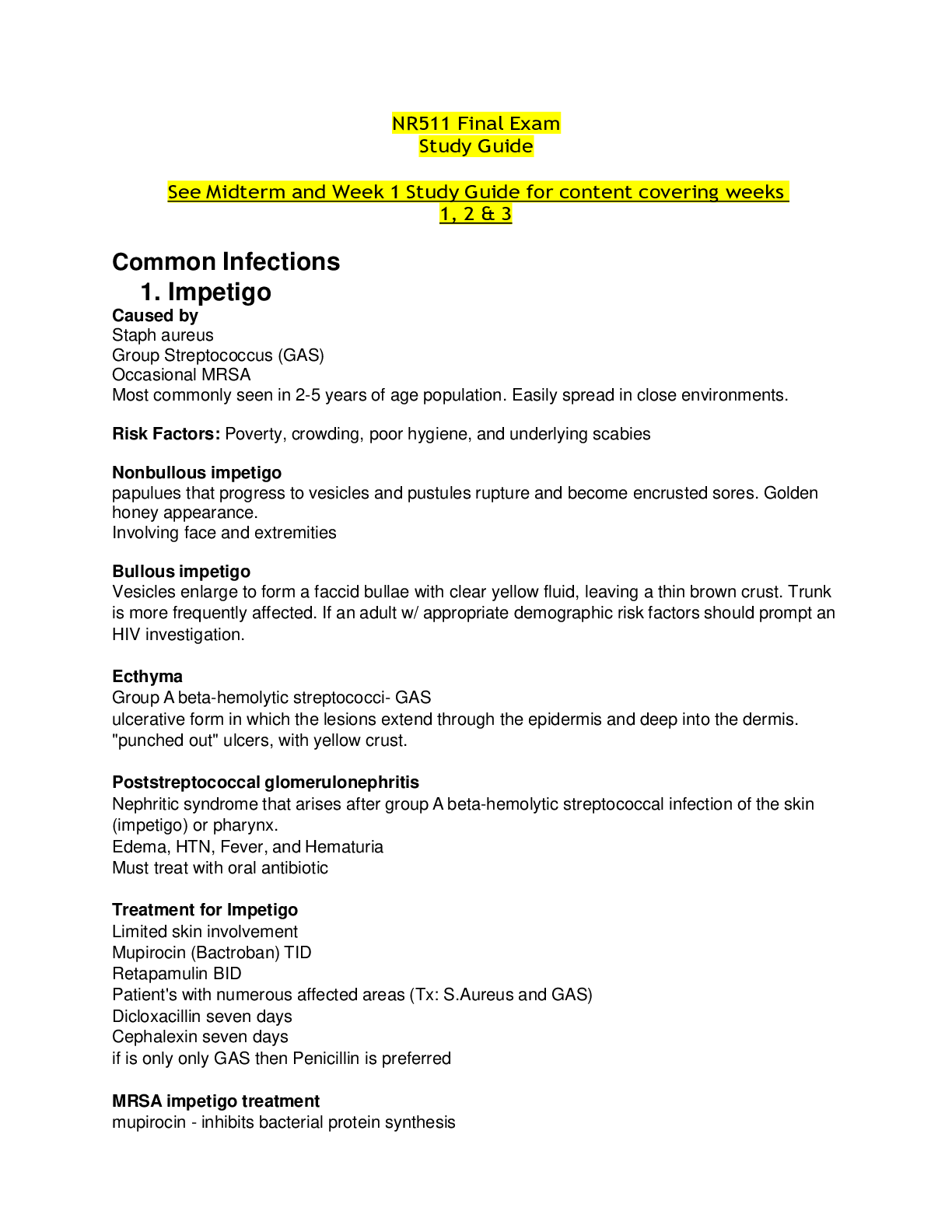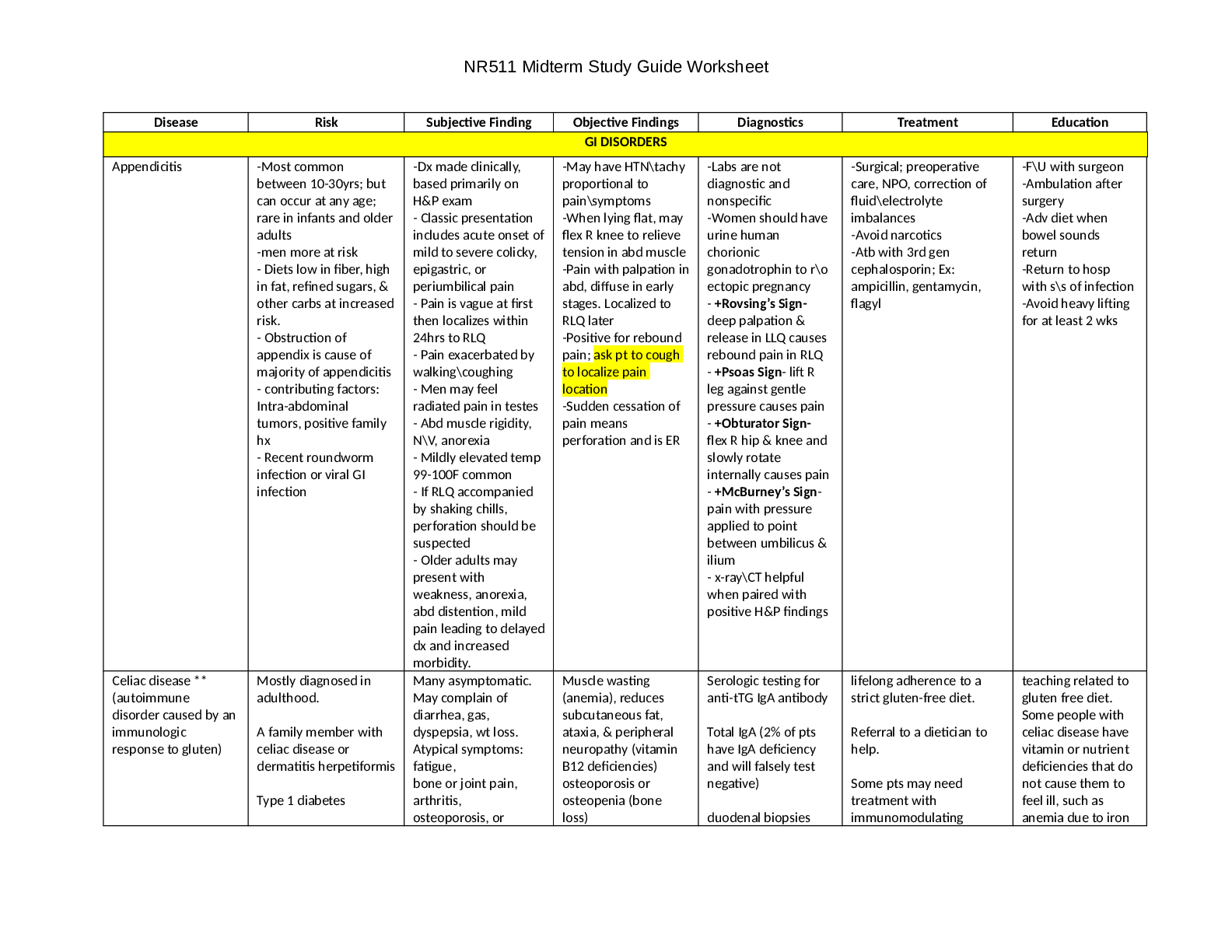*NURSING > STUDY GUIDE > NR511 Final Exam Study Guide-(11-2019) (1). (All)
NR511 Final Exam Study Guide-(11-2019) (1).
Document Content and Description Below
NR511 Final Exam Study Guide 1. Signs and symptoms and management of musculoskeletal sprains/strains/dislocations 16-15 When Maxwell, age 12, slid into home plate while playing baseball, he injured ... his ankle. The nurse practitioner is trying to differentiate between a sprain and a strain. A sprain A. is an injury to the ligaments that attach to bones in a joint. B. is an injury to the tendons that attach to the muscles in a joint. C. is an injury resulting in extensive tears of the muscles. D. is an injury th 16-98 Alexander, age 12, sprained his ankle playing ice hockey. He is confused as to whether to apply heat or cold. What should the nurse practitioner tell him? A. “Use continuous heat for the fi rst 12 hours and then use heat or cold to your own preference.” B. “Use continuous cold for the fi rst 12 hours and then use heat or cold to your own preference.” C. “Apply cold for 20 minutes, then take it off for 30 to 45 minutes; repeat this for the fi rst 24 to 48 hours while awake.” D. “Alternate between cold and heat for 20 minutes each for the fi rst 24 to 48 hours.” 16-69 Ankylosis is defi ned as A. muscle shortening. B. joint stiffness. C. malposition of a joint. D. dislocation of a joint. 16-108 Jill, age 49, has recently begun a rigorous weight- lifting regimen. She presents to the primary care offi ce with a shoulder dislocation. Which of the following clinical manifestations lead the nurse practitioner to suspect an anterior shoulder dislocation over a posterior dislocation? A. Inability to shrug the shoulder B. Absence of pain C. Inability to rotate the shoulder externally D. Shortening of the arm 16-123 In assessing an infant for developmental dysplasia of the hip (DDH), the practitioner places the infant supine, fl exes the knees by holding the thumbs on the inner mid- thighs, with fi ngers outside on the hips touching the greater trochanters, stabilizes one hip, and abducts and gently pulls anteriorly on the other thigh. If this external rotation feels smooth with no sound present, there is no hip dislocation. This is A. the Allis test. B. Lasègue’s sign. C. the McMurray test. D. the Ortolani maneuver. 16-124 Emily, age 12, presents to the clinic with another muscle strain from one of her many sports activities. The nurse practitioner thinks that the patient was probably never taught about health promotion and maintenance regarding physical activity. What information should be included in patient teaching? A. “After an activity, if any part hurts, apply ice for 20 minutes.” B. “You must fi rst get in shape with a rigorous schedule of weight training, and then you can participate in any activity once you are physically fi t.” C. “After any strenuous activity, you must completely rest your muscles before beginning your next activity.” D. “Stretching and warm- up exercises are an important part of any exercise routine.” 16-27 Upon assessment, the nurse practitioner notes unilateral back pain that had an acute onset and increases when standing and bending. A straight- leg test is negative. The most likely differential diagnosis is A. herniated nucleus pulposus. B. muscle strain. C. osteoarthritis. D. spondylolisthesis. 16-67 June, age 67, presents with back pain with no precipitating event. The pain is located over her lower back and muscles without sciatica, and it is aggravated by sitting, standing, and certain movements. It is alleviated with rest. Palpation localizes the pain, and muscle spasms are felt. There was an insidious onset with progressive improvement.NR511 Final Exam Study Guide What is the most likely differential diagnosis? A. Ankylosing spondylitis B. Musculoskeletal strain C. Spondylolisthesis D. Herniated disk 2. Signs and symptoms and management of spinal disorders (spondylosis, stenosis, etc.) 6-79 Sam, age 73, has lumbar spinal stenosis and asks which exercises he should do to help his condition. You advise him to A. do any exercise that results in hyperextension of the lumbar spine. B. do exercises that encourage lumbar fl exion and fl attening of the lumbar lordotic curve. C. refrain from exercising. D. see a surgeon because surgery is the best treatment option. 7-57 Clients with spinal cord injuries often have bowel incontinence and need to have a bowel program instituted. What is the most effective way to stimulate the rectum to evacuate in the quadriplegic client? A. Administer stool softeners every night. B. Insert a rectal suppository and then eventually perform digital stimulation. C. Administer laxatives every other night. D. Administer enemas on a regular basis. 13-12 Decreased bladder capacity; bladder irritation from a urinary tract infection, tumor, stones, or irritants such as caffeine and alcohol; and central nervous system disorders or spinal cord lesions are all contributing factors to A. stress urinary incontinence. B. urge urinary incontinence. C. overfl ow urinary incontinence. D. refl ex urinary incontinence. 16-50 Beth, age 49, comes in with low back pain. An x- ray of the lumbar/sacral spine is within normal limits. Which of the following diagnoses do you explore further? A. Scoliosis B. Osteoarthritis C. Spinal stenosis D. Herniated nucleus pulposus 16-72 Hilda, age 73, presents with a complaint of low back pain. Red fl ags in her history of a minor fall, osteopenia, and prolonged steroid use for systemic lupus erythematosus suggest the possibility of which of the following serious underlying conditions as the cause of her low back pain? A. Cancer B. Cauda equina syndrome D spinal fracture 16-14 Mrs. Kelly, age 80, has a curvature of the spine. This is likely to indicate which agerelated change? A. Lordosis B. Dorsal kyphosis C. Scoliosis D. Kyphoscoliosis 16-90 What disorder affects older individuals, particularly women, and is characterized by pain and stiffness in the cervical spine and shoulder and hip girdles, along with signs of systemic infection such as malaise, weight loss, sweats, and low- grade fever? A. Fibromyalgia syndrome B. Myofascial somatic dysfunction C. Polymyalgia rheumatica D. Reiter’s syndrome 3. Recognition and immediate management of cauda equina syndrome 16-11 The most common cause of cauda equina syndrome is A. fracture. B. hematoma. C. lumbar intervertebral disk herniation. D. space- occupying lesion. 16-60 Sandy, age 49, presents with loss of anal sphincter tone, impaired micturition, incontinence, and progressive loss of strength in the legs. You suspect cauda equina syndrome. What is your next action? A. Order physical therapy B. Order a lumbar/sacral x- ray C. Order extensive lab work D. Refer to a neurosurgeon 16-72 Hilda, age 73, presents with a complaint of low back pain. Red fl ags in her history of a minor fall, osteopenia, and prolonged steroid use for systemic lupus erythematosus suggest the possibility of which of the following serious underlying conditions as the cause of her low back pain? A. Cancer B. Cauda equina syndrome C. Neurological compromise D. Spinal fractureNR511 Final Exam Study Guide 4. Maneuvers and expected findings with joint pain (knee, shoulder, wrist, etc.) Chap 16 16-24 To aid in the diagnosis of meniscus damage, which test should a nurse practitioner perform? A. The bulge test B. The Lachman test C. The drawer test D. Apley’s compression test 16-35 You are assessing Jamal, age 16, after a football injury to his right knee. You elicit a positive anterior/posterior drawer sign. This test indicates an injury to the A. lateral meniscus. B. cruciate ligament. C. medial meniscus. D. collateral ligament. 16-29 The straight leg–raising maneuver can be used to diagnose A. nerve root compression. B. a fractured hip. C. an anterior cruciate ligament tear. D. tendinitis. 16-96 What is the name of the test used to assess for nerve- root compression? A. The Apley scratch test B. The drop arm test C. Finkelstein’s test D. Spurling’s maneuver 16-123 In assessing an infant for developmental dysplasia of the hip (DDH), the practitioner places the infant supine, fl exes the knees by holding the thumbs on the inner mid- thighs, with fi ngers outside on the hips touching the greater trochanters, stabilizes one hip, and abducts and gently pulls anteriorly on the other thigh. If this external rotation feels smooth with no sound present, there is no hip dislocation. This is A. the Allis test. B. Lasègue’s sign. C. the McMurray test. D. the Ortolani maneuver. [Show More]
Last updated: 2 years ago
Preview 1 out of 15 pages

Buy this document to get the full access instantly
Instant Download Access after purchase
Buy NowInstant download
We Accept:

Reviews( 0 )
$12.00
Can't find what you want? Try our AI powered Search
Document information
Connected school, study & course
About the document
Uploaded On
Aug 28, 2021
Number of pages
15
Written in
Additional information
This document has been written for:
Uploaded
Aug 28, 2021
Downloads
0
Views
75












